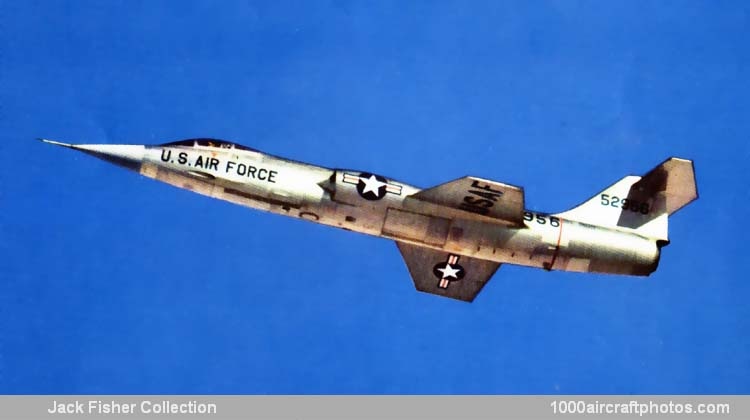05/31/2010. Remarks by Johan Visschedijk: "Already during the first phase of the XF-104 trials it had become evident that, even with the afterburning version of the J65 turbojet, the production aircraft would not be able to reach design maximum speed. Furthermore, directional stability problems and the need to carry more fuel internally required the lengthening of the fuselage.
Accordingly, the YF-104A service trial aircraft, and subsequent production versions, had the fuselage lengthened from 49 ft 2 in (14.99 m) to 54 ft8 in (16.66 m), the T-tail surfaces moved aft, and engines changed to various models of the General Electric J79. In addition, these aircraft were fitted with variable shock-control ramp in the fuselage-side air intakes, forward- (in place of rearward-) retracting landing gear, and increased fuel capacity.
The first YF-104A was flown on February 17, 1956, and the program appeared to move smoothly towards providing the Air Force with its first bisonic fighter. Unfortunately, persistent difficulties in developing the afterburner for the J79 and the USAF decision in April 1956 to add heat-seeking Sidewinder missiles to the aircraft's armament, combined in forcing the schedule to slip, with the first operational Starfighter squadron being formed only during January 1958.
Moreover, changing Tactical Air Command requirements and the anticipated early availability of more flexible supersonic fighters, led to a review of the F-104 program. Finally, by December 1958 the USAF drastically reduced its contracts (at one point orders for 722 aircraft had been placed) and Lockheed went on to produce only 296 Starfighters for the USAF (two XF-104s, seventeen YF-104As, 153 F-104As, 26 F-104Bs, 77 F-104Cs and twenty-one F-104Ds). Fortunately, major foreign MAS- and MAP-funded programs boosted Lockheed's Starfighter production to 741, and added 48 co-produced aircraft and 1,789 license-built aircraft, for a grand total of 2,578.
The 153 F-104A-LOs were built by Lockheed in seven blocks-F-104A-1-LO to F-104-30-LO, with final acceptance by the USAF in December 1958. Initially powered by the J79-GE-3A turbojet but retrofitted beginning in April 1958 with the more reliable J79-GE-3B of 9,600 lb (4,354 kg) dry thrust and 14,800 lb (6,713 kg) with afterburner. Design armament consisted of a 0.787 in (20 mm) M-61 Vulcan cannon and two wing tip-mounted AIM-9B Sidewinder missiles. However, the early cannon's unreliability forced its removal in November 1957 before delivery of F-104As to operational squadrons; improved cannon were re-installed in 1964.
Modifications introduced during Service life included substitution of an upward-firing ejector seat for the initial downward-firing unit, standard installation of the ventral fin and flap-blowing system, and retrofitting of either the J79-GE-19 (17,900 lb/8,119 kg afterburning thrust) on some USAF aircraft or J79-GE-11A (15,800 lb/7,167 kg maximum thrust) on F-104As of the Pakistan Air Force. NASA operated two F-104As between October 1957, when it received s/n 56-734, and December 1962, when s/n 56-749 crashed; a third (s/n 56-790) was obtained in December 1966.
One F-104A-15-LO (s/n 56-770) went to the RCAF as 12700 to serve as a pattern aircraft for the Canadian Starfighter, ten were transferred to Pakistan, at least 25 went to Taiwan, and 32 ended up in Jordan. In addition, three (s/n 56-756, 56-760, 59-762) were modified as NF-104As in 1963 to be used in the USAF astronaut training program conducted by the Aerospace Research Pilot School at Edwards AFB. They were fitted with a 6,000 lb (2,722 kg) thrust Rocketdyne AR-2 auxiliary rocket engine above the jetpipe, 2 ft (61 cm) wing tip extensions, the enlarged vertical surfaces of the F-104G, and hydrogen-peroxide control thrusters at the nose, tail and wing tips.
In 1960, 24 YF-104As and early production F-104As were modified as remote-controlled target drones. Design work on an unarmed photographic-reconnaissance version of the Starfighter had begun in November 1954 but a contract for eighteen (s/n 56-939 to 56-956) Model 383-93-04 RF-104A-LOs was cancelled in January 1957 before completion of the first RF-104A. The proposed TF-104A-LO unarmed, two-seat training version was not proceeded with as the USAF preferred the combat-capable F-104B."
